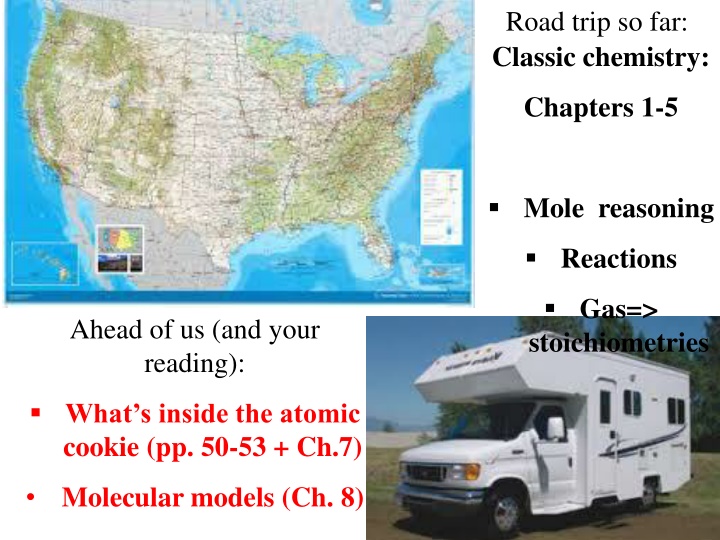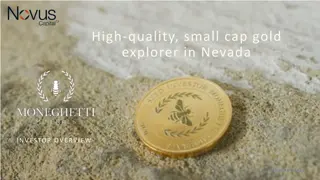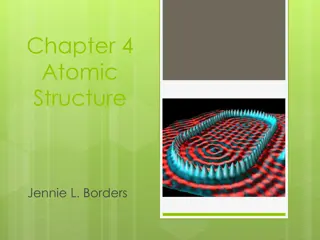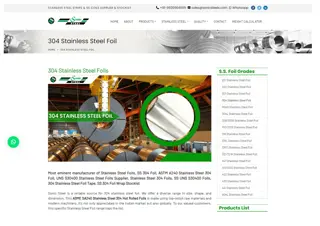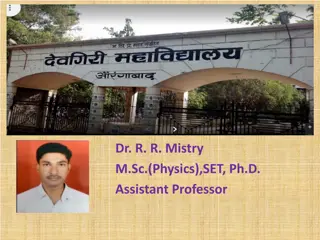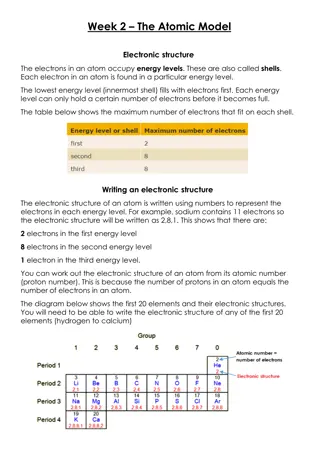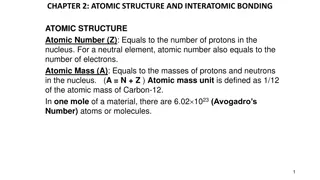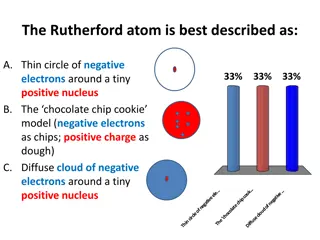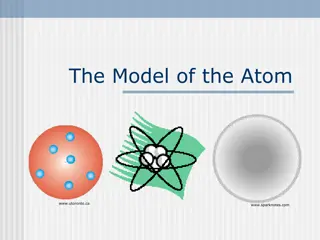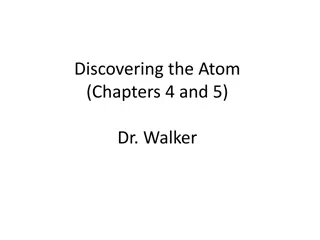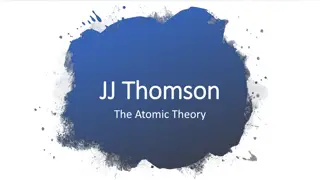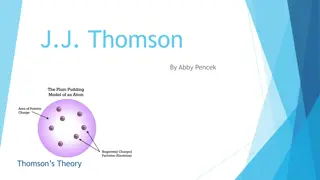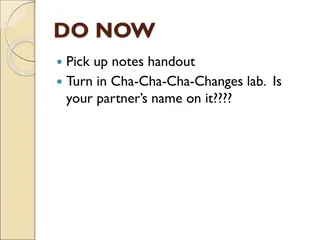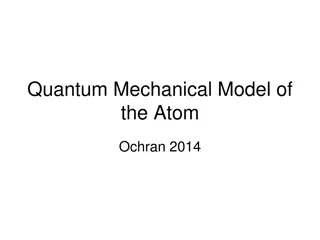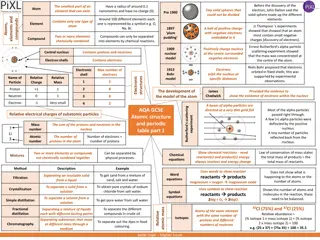Journey Through Atomic Models: From Thomson's Plum Pudding to Rutherford's Gold Foil Experiment
Explore the evolution of atomic models starting with J.J. Thomson's Plum Pudding Model in 1897, where the discovery of electrons led to the belief of a positive "glue." Follow the progression to Ernest Rutherford's Gold Foil Experiment in 1910, challenging the Plum Pudding Model and unveiling the nucleus.
Download Presentation

Please find below an Image/Link to download the presentation.
The content on the website is provided AS IS for your information and personal use only. It may not be sold, licensed, or shared on other websites without obtaining consent from the author.If you encounter any issues during the download, it is possible that the publisher has removed the file from their server.
You are allowed to download the files provided on this website for personal or commercial use, subject to the condition that they are used lawfully. All files are the property of their respective owners.
The content on the website is provided AS IS for your information and personal use only. It may not be sold, licensed, or shared on other websites without obtaining consent from the author.
E N D
Presentation Transcript
Road trip so far: Classic chemistry: Chapters 1-5 Mole reasoning Reactions Gas=> stoichiometries Ahead of us (and your reading): What s inside the atomic cookie (pp. 50-53 + Ch.7) Molecular models (Ch. 8)
Todays Student Learning Objective (SLO): SLO#2 Students should be able to provide a basic description of the atomic and electronic structures of atoms . Translation: What s inside the atomic cookie . and how do we know this ???
The first try at mapping the atomic cookie: J. J. Thomson s `Plum Pudding Model : 1897 (see text p.50 ) J.J. Thomson Cavendish Labs, Cambridge UK J.J s `Cathode Ray Tube (CRT)* *factoid: Thomson was said to be astonishingly bad in the lab and fumble-fingered; the CRT was made by a gifted glassblower, E. Everett
Atomic structure: try 1 Thomsons atom (continued) Schematic of Thomson s critical experiments 1)Battery voltage tears something (e-) 2) e- beam from cathode (- plate) accelerated towards (+) plate http://session.masteringchemistry.com/problemAsset/1070873/24/BLB-1070873-CRT_v2.jpg away from metal cathode 3) Fields applied and results observed on `TV screen
Atomic structure: try 1-Thomsons atom (continued) Basic result of Thomson s CRT experiments: All the materials subjected to high voltage in the tube vomited the same kind of `negative particles-dubbed the electron. Thomson s Conjecture from his CRT experiments If all matter has negative electrons, there must be a counterbalancing positive glue that sticks to and neutralizes the electrons negative charge (since matter is normally neutral).
Atomic structure: try 1 Thomsons atom (continued) Thompson s conjecture morphed into the first experimentally derived atomic model: The Plum Pudding Model 1 http://images.tutorvista.com/content/atoms-and-nuclei/plum-pudding-model.jpeg http://t2.gstatic.com/images?q=tbn:ANd9GcTlP2d6KFMFmGC5cUWnKpqotpPxc06_WbQ078Oul47_RgeYtky-fg Cookie metaphor -if you ve never had plum pudding 1 J.J. Thomson Cathode Rays, Philosophical Magazine44, 295 (1897)
Testing the plum pudding atom: Rutherfords gold foil experiment (1910) (see also: page 52 of text) Ernst Rutherford Physical Laboratory Manchester University, UK http://myweb.usf.edu/~mhight/rutherfordlab.jpg http://137.193.61.237/images/theory_abb1.jpg Rutherford sGold foil apparatus* *Factoid: it s really his students-Geiger and Marsden-who machine the device and do the measurements.
Atomic structure: testing Thomsons Plum Pudding atomic model (continued) Schematic of Rutherford s `gold foil apparatus Microscope Rotated to detect scintillations http://www.antonine-education.co.uk/Image_library/Physics_5/Nuclear_physics/alpha.gif Alpha ( ) particles=He+ ZnS screen is a scintillating surface Gold Foil Experiment lore 1) Marie Curie supplied the radon = source. 2) It required ~ 1 hour sitting in absolute dark to condition eyes. 3) You could only observe scintillations for 1-2 minutes before desensitizing.
Atomic structure: testing Thomsons Plum Pudding Atomic Model(continued) Other Facts about the Gold Leaf Experiment rarely mentioned: particles move crazy fast: velocity ~ 0.1c ~7*107 mph (can get to NYC from here in ~0.01 sec) particles are crazy overweight compared to the electrons (e-) in a gold atom: ~800X heavier than all 79 e- in gold atom The gold foil is crazy thin: ~ 8.6*10-6 cm thick (~1/3000 the thickness of cheap toilet paper )
Atomic structure: testing Thomsons Plum Pudding Model (continued): Reminder of the Plum Pudding Model being tested http://images.tutorvista.com/content/atoms-and-nuclei/plum-pudding-model.jpeg
Given the preceding facts, predict how the particles will behave after striking the gold foil if the structure of gold is as described in Thomson s Plum Pudding model . A. Bounce straight backwards off the foil like a baseball hitting a wall. B. Punch through the foil like it wasn t there. C. Scatter off the foil randomly in all directions. 78% 20% 2% Scatter off the fo.. Punch through... Bounce straigh...
Plum Pudding model predicts the massive particles will pass ~un-deflected through gold foil made of diffuse matter particles http://images.tutorvista.com/content/atoms-and-nuclei/plum-pudding-model.jpeg Rutherford s observationsmostly agree with above. Butsometimesa few curve off significantly And once and in a great while, one bounces back. ! Gold foil
Atomic structure: testing Thomsons Plum Pudding Atomic Model(continued) Pictorial summary of results of gold foil experiment http://mysite.verizon.net/kdrews47/introterms/goldfoil.gif Seminal publication on results: Geiger H. & Marsden E., On the Diffuse Reflectance of -Particles Proceedings of the Royal Society, Series A 82: 495 500 (1909)
Atomic structure: testing Thomsons Plum Pudding Atomic Model(continued) Rutherford s famous `take on Marsden and Geiger s results: Like firing a howitzer at tissue paper and having the shell bounce back !!
Which model below best explains the gold foil scattering data? 33% 33% 33% A. Thin, dense electron ring around large, dense ball of positives. B. diffuse, continuous ball of electrons around tiny, dense ball of positives. C. Inner thin, dense positive ring surrounded by outer thin,dense electron ring. Thin, dense... diffuse, con... Inner thin, ...
Atomic structure: Rutherfords Atomic Model Rutherford s Atom:1911 The Second Experimentally-Based Model of the Atom Electrons in diffuse cloud around tiny (but massive) positive charged nucleus. E. Rutherford, F.R.S. The Scattering of and Particles by Matter and the Structure of the Atom Philosophical Magazine Series 6, vol. 21, p. 669-688 (1911)
Dimensions of Rutherford atomic model* *derived from statistics of gold leaf scattering experiment Nuclear radius Electronic cloud radius ~ 10-10 meters Electronic radius/Nuclear radius ~ 10+5 ~10-15 meters Masses of subatomic pieces** Subatomic piece proton neutron electron ** from J. Aston development of mass spectroscopy at Cavendish Labs (w/Rutherford as its new Director) Mass (g) 1.67*10-30 1.67*10-30 9.11*10-34 Relative mass 1 1 0.0005
Atom dimensions in familiar terms. Metaphor 1 Electrons start here (~2.4 miles past cheap seats) 3 Baseball as nucleus PS: Yanks rule Boston drools Old Yankee Stadium, the Bronx
http://www.aaccessmaps.com/images/maps/us/ny/nyc_area_hwy/nyc_area_hwy.gifhttp://www.aaccessmaps.com/images/maps/us/ny/nyc_area_hwy/nyc_area_hwy.gif Nucleus(+) ~ dimension of Rutherford s electronic cloud (-) (2.4 mile radius from baseball nucleus)
Atom dimensions in familiar terms Example 2 U-Do-It Super Target store in Omaha, Neb., is the nucleus Assume the radius of the store is 75 m (0.75 km) Assume electronic cloud is 100,000X larger in diameter
Atom dimensions in familiar terms U-Do-itExample 2: where is electron cloud? Chicago NYC Paris Beijing Nucleus= Super Target store in Omaha
Which city best defines the boundary of Rutherford s electron cloud if a Super Target store in Omaha is the nucleus ? A. Chicago:7*102 km away B. NYC: 2*103 km away C. Paris: 7*103 km away D. Beijing 1.6*104 km away 0% 0% 0% 0% Store radius = 75 m Electron radius =100,000 Nuclear radius NYC: 2*103 km away Chicago:7*102 km away Paris: 7*103 km away Beijing 1.6*104 km away
Paris Nucleus=Super Target store in Omaha
OTHER METAPHORS TO `GRASP ATOMIC DIMENSIONS Pencil dot + string (clickers) Penny analogy (clickers) paper + scissors (board work) Pea=nucleus volume of electrons (board work)
If a pencil dot, which has a radius of~ 0.02 cm, is the nucleus, how many cm away are the electrons ? A. 200,000 cm B. 20,000 cm C. 2000 cm D. 200 cm E. I have no clue 20% 20% 20% 20% 20% 2000 cm 200 cm 20,000 cm 200,000 cm I have no clue
If an electron is a penny , how much money do you need to equal the mass of 1 proton ? (mass of proton/mass of electron ~1836) A. $18.36 B. $ 1836 C. $1.83(6) D. 0.0005 $ E. No clue 20% 20% 20% 20% 20% $18.36) $1,836) 0.0005 $ $1.83(6) No clue
Volume comparison The electron cloud volume is 1015 times bigger than the nuclear volume Electron cloud volume ~ volume of water in Honeoye Lake, NY (1015 times pea volume) Nuclear volume= 1 pea (~0.065 cm3)
